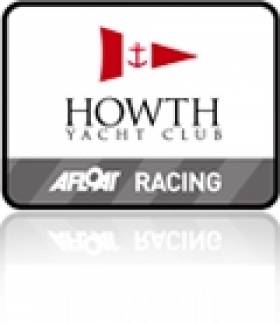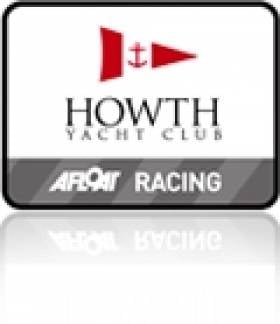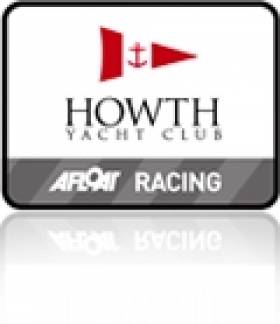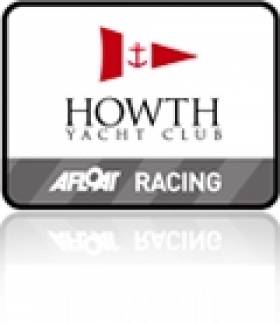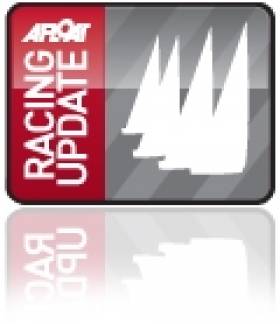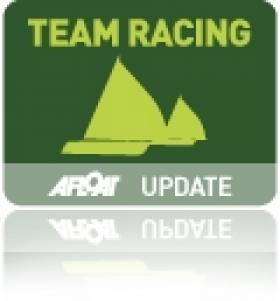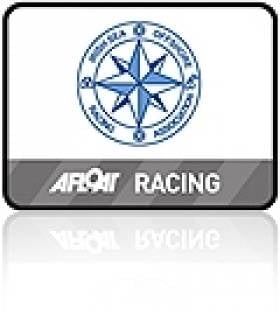Displaying items by tag: Howth Yacht Club
#cruiserracing – The opening day of the ICRA Nationals at the Royal Irish YC in Dun Laoghaire offered W M Nixon the chance of a painless transition through Friday 13th, and the discovery that there is a life after spinnakers.
In the complete absence of any completely new boats in the hundred-plus lineup for the Irish Cruiser Racing Association's three day Nationals on Dublin Bay, it made sense to focus instead on the lovingly maintained and upgraded veterans in the fleet by sailing on a boat which has been an important part of the Irish sailing story since 1979.
The 30ft Club Shamrock Demelza (she's named after the heroine of a long-forgotten TV drama series based in Cornwall) was one of ten or so boats which raced as a hyper-keen almost one design class in Crosshaven in the late 1970s and early '80s.
Ron Holland's Shamrock Half Tonner design had been achieving racing success since it appeared in 1975, with Silver Shamrock – skippered by Harold Cudmore with all the usual suspects in the crew – winning the Half Ton Worlds at Trieste in 1976. But although they were able little boats with adequate accommodation – American sailor Stuart Woods crossed the Atlantic single-handed in one – the more clubbable element in Royal Cork persuaded the designer and the builders in Cork that a Shamrock with roomier accommodation made possible by a much larger coachroof, with a shorter cockpit and wheel steering, would better meet the needs of club sailors.
For the more austere racing types, the Club Shamrock which emerged from all these discussions looked to be a frivolous boat for party animals, rather than a serious racing proposition. But it speaks volumes for the basic quality of the Ron Holland hull design that the "comfy party boats" could hold their own very well indeed inshore and offshore, if competently sailed.
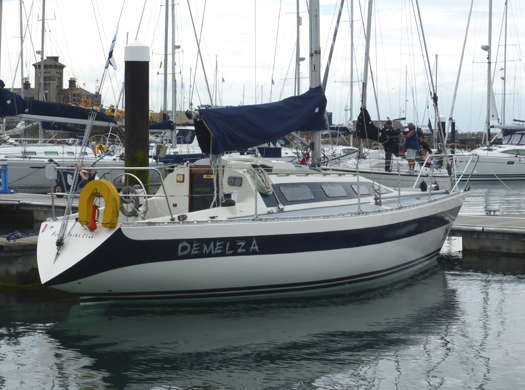
The pintail stern on Demelza makes her very slippy to windward, but her performance suffers on a reach. Photo: W M Nixon
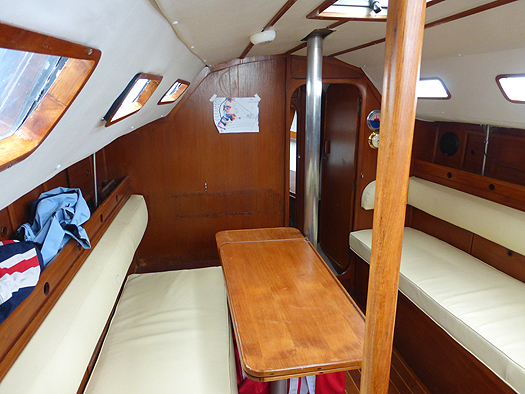
The Club Shamrock version provided a saloon which seemed exceptionally roomy in the 1970s. Photo: W M Nixon
Thus Brian MacManus of Dun Laoghaire, who owned and campaigned Silver Shamrock herself for ten keenly contested offshore seasons in the Irish Sea, remembers that it was the devil's own job getting clear ahead of the almost clunky-looking Club Shamrocks, and it was wellnigh impossible when that Club Shamrock was Demelza, owned and sailed by Neville Maguire.
But we're getting ahead of the story. Back in 1979, Demelza was a new build for Stafford Mansfield of Crosshaven. A key member in his crew was his schoolboy son Mark, later an Olympic sailor and still very much in demand as a frontline helmsman. But back in the late 1970s, it was Demelza which propelled young Mark into the offshore racing game.
He modestly recalls that they won more than their fair share of prizes. But as the boat was raced with complete dedication, there was nothing unfair about their haul of trophies. Eventually, with their sights on the db1 Luv Is, the Mansfields sold Demelza on to Neville Maguire of Howth, thereby bringing another name of international sailing repute into the story, as it was aboard the little boat that Gordon Maguire made early forays offshore.
However, Demelza could win whether Gordon was there or not. In 1984, on the very weekend in August that saw Gordon winning the Irish Windsurfer Nationals in Kerry, in the Irish Sea Neville won the concluding race of the ISORA Championship to take the title – and that in a year in which he had also won his class in the Round Ireland.
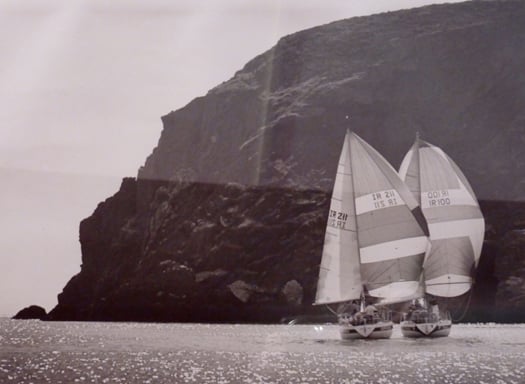
Glued together. Harry Byrne's Club Shamrock Rapparee and Neville Maguire's sister-ship Demelza in one of their many contests during the 1980s, seen here closing in under Howth Head while positioning themselves for the lee mark.
The Club Shamrocks found a new lease of life in Howth, and for many years a feature of the racing there was the continuing battle between the sister Club Shamrocks, Harry Byrne's Rapparee and Neville Maguire's Demelza. They seemed to be glued together in some races, and years afterwards they can still recall every last move afloat, and the final outcome of dozens of contests.
Neville Maguire had long since celebrated his 80th birthday when he sold Demelza to Windsor Laudan and Steffi Ennis for what is only the third ownership in the boat's gilded existence. Steffi Ennis is longtime Howth sailing family, while Windsor is Irish Sea through and through. His boyhood was spent at picturesque Porth Dinnllaen in North Wales, where his parents ran the famous pub on the beach, then when he was 16 they moved to Holyhead and he became so involved in offshore racing that after zillions of crossings of the Irish Sea, he became Howth based.
Demelza is one very lucky little ship, so where better to spend Friday 13th June? In Windsor and Steffi's ownership, she has people who appreciate her good qualities, which are many, for she's one gallant little boat. And as for the fact that when the spinnaker is set the Shamrock can be a right handful, well, they've solved the problem simply by opting to keep her as a much-loved family cruiser while racing her in the non-spinnaker class.
That said, they've raised non-spinnaker racing to a new level. Last year, they were right on the pace, winning the Lambay Lady for the clearest win in Howth's annual Lambay Race, and topping their class with six bullets in the Volvo Dun Laoghaire Regatta. All this despite the fact that the Club Shamrock's very pintailed hull is at a distinct disadvantage when reaching, or when running in anything over Force 4. So clearly this pair of keen owners are employing some very special skills, and the opening day of the ICRA Nats offered an opportunity to find out just how they do it, and also to get the flavour of this year's main regatta on the east coast.
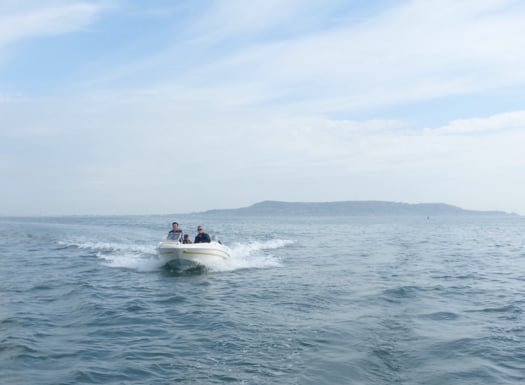
Good start to the day. With Howth Head well astern across Dublin Bay, the rest of the crew catch up with the commuter boat as Demelza enters Dun Laoghaire Harbour.
Photo: W M Nixon
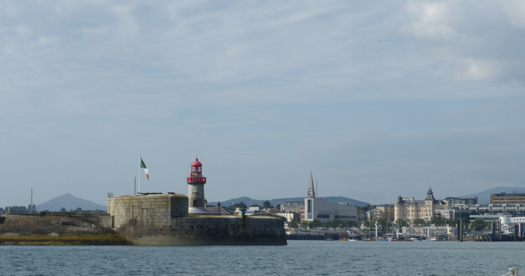
The intrusion of the new library into the Dun Laoghaire waterfront is a shock for those who haven't seen it before. Photo: W M Nixon
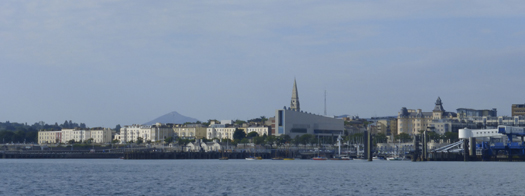
It is only from mid-harbour that you're fully aware of the damage done by the new library to Dun Laoghaire's classic waterfront. Photo: W M Nixon
Being on time is a good start. Ship's orders for visiting journos were to be aboard with the skipper and mate by 0800 in Howth Marina, and get the boat to Dun Laoghaire Marina comfortably in time for the rest of the crew coming across Dublin Bay in a fast runabout which would subsequently be used for daily commuting while the boat stayed on in Dun Laoghaire, all to be well in time for first gun at 1055hrs.
The sense of anticipation is palpable, and while the sight of the new "library and cultural centre" blighting the Dun Laoghaire waterfront was a shock for those who hadn't been it before, at the Royal Irish the happy morning mood took over again, with the place ahive with activity which is comprehensible only to regular regatta racers, and confusing for those not in the loop.
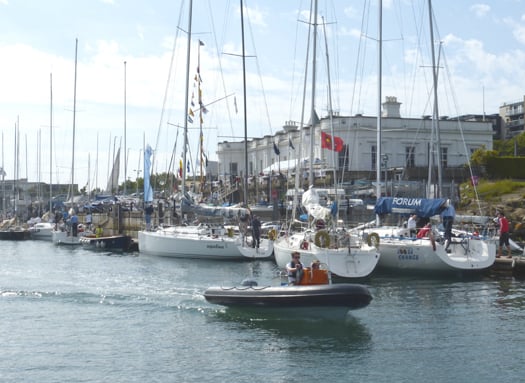
"Glad morning again". The Royal Irish YC is the perfect setting for that special pre-regatta sense of anticipation. Photo: W M Nixon
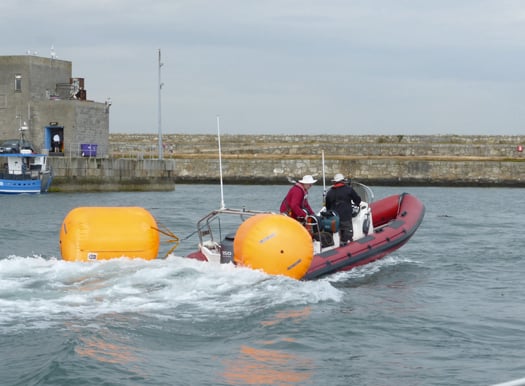
The Dun Laoghaire regatta machine swings into action with supplementary race marks heading seaward. Photo: W M Nixon
Sufficient to say that once again the mighty Dun Laoghaire regatta machine was moving smoothly into action with three different race areas being provided in the bay, and on the waterfront the club gearing up to receive a host of hungry and thirsty post-race sailors. There was a nice moment when Mark Mansfield – up in Dublin to helm John Maybury's J/109 Joker II in the Nationals – called over to say Demelza had never looked better. Other old friends to meet and greet - do other sports have quite the same level of banter as sailing? – and then out to the Bay and suss up the opposition.
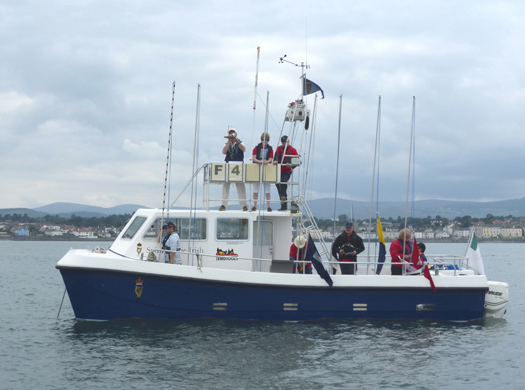
Were it not for the many volunteers manning the committee boats, an event like the ICRA Nationals simply couldn't happen. Photo: W M Nixon
There were two obvious boats in Class 6 for Demelza to beat – Jim McCann's Mustang 30 Peridot, and Sean and Kristina O'Regan's Dehler 31 Vespucci. But an unexpected addition to the lineup of ten or so boats was Frank Friel's Fist 32s5 Effex II, usually completely a cruiser and thus given a low ECHO handicap. So she was in among smaller craft, but this provided another handy target boat for the Laudan-Ennis team.
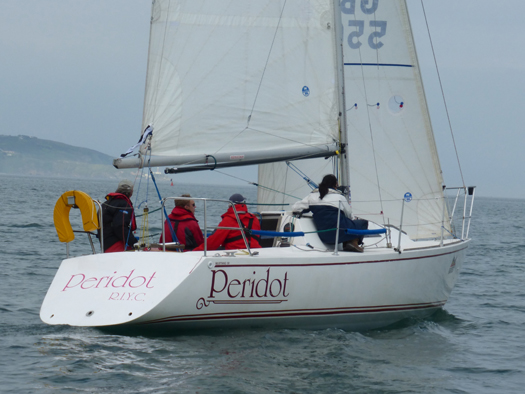
Jim McCann's Peridot was an ideal competitive match for Denmelza. Photo: W M Nixon
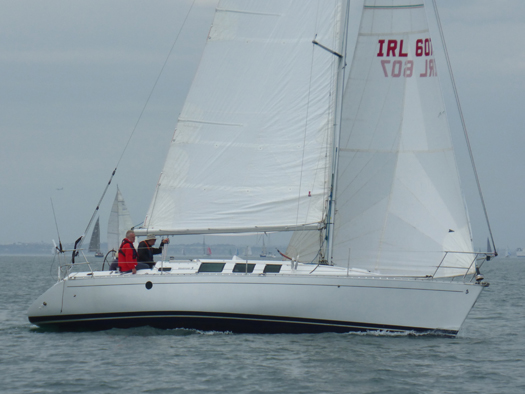
Frank Friel's Effex II took line honours in the first race. Photo: W M Nixon
And that's exactly what they are. A team. It worked beautifully in the countdown to the start, with Steffi putting the course on cockpit display and keeping tabs on time and any other messages via VHF, while Windsor was able to settle into the developing day, getting a sense of what the wind was trying to do while exchanging ideas with his afterguard of Conor Walls and Francis Ennis (Steffi's dad).
They set a hot suit of brown sails on Demelza's masthead rig, with a main from North while the genoa is Philip Watson. Within the limits of doing without spinnaker, everything is optimised and the light breeze from southeast, sometimes swinging a bit more east, is getting a useful bite to it as the first of the ebb is running southeast across our start area in the outer water of Scotsmans Bay.
As is usually the case, in these conditions on the initial beat it pays to go to the wall, closing the shore with Demelza powering along and loving it - after a good start, our skipper finds clear wind and makes the most of it. Fortunately the downwind leg become a dead run, and a masthead-rigged boat can make hay running goosewinged, but even so our lead is under increasing threat from the First 32s5, and Effex II just pips us for line honours, though on IRC Demelza has it by a mile.
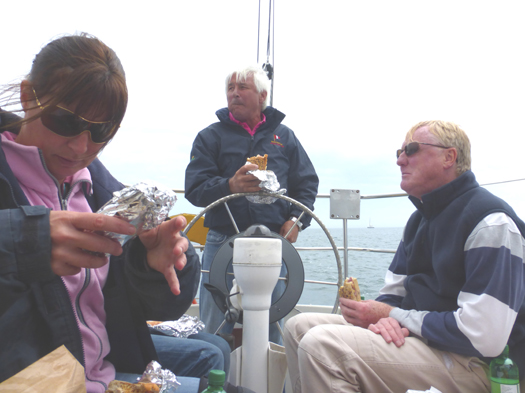
Lunch break – but definitely no alcohol until racing is finished for the day. Photo: W M Nixon
The mood over lunchtime sangers is of good work done, but more work still to do. But then that wretched new library intrudes again. You just can't get away from it. While it looks bad enough from within the harbour, from Scotsmans Bay it looks ten times worse. Out there, you can see how it has entirely blocked off a pleasant terrace of classic Dun Laoghaire waterfront houses from any enjoyment of the sunset. Compared to this new monstrosity, the Berlin Wall was surely a lovely creation.
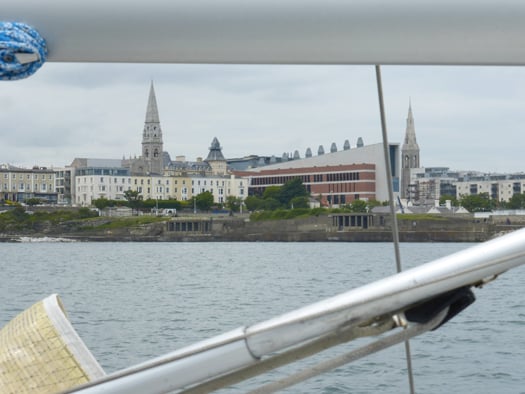
You just can't get away from it..........
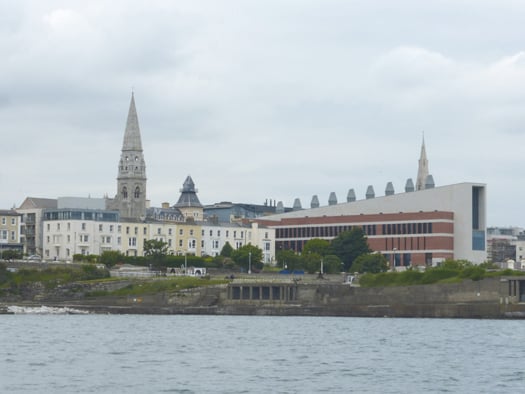
.........and farewell, Sunset Strip. The new Dun Laoghaire library has permanently blocked off the sunset for an entire terrace of houses. Photo: W M Nixon
But fortunately for our entertainment, we had a glimpse of other divisions racing, with Classes 0 and 1 running past nearby, and Denise Phelan's Ker 37 Jump Juice up from Cork doing great things on the run to make up lost ground. For the biggies as for us, the beat out of Dublin Bay was tactically fascinating as the ebb had reached full strength. Jump Juice read it to perfection, even if her winning tack on port brought her right through our starting area.
But once again the Dun Laoghaire regatta machine took it all calmly in its stride. And when we came to make our start, our skipper read it spot on, working his timing and the sluicing ebb to such an accurate level that we swept by the committee boat only a nano-second after the signal, and had congratulations from a race officer for getting it just right.
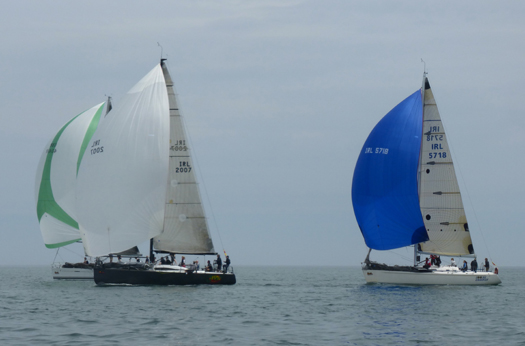
Jump Juice from Cork starting to make up lost ground on the run in Class O Photo: W M Nixon
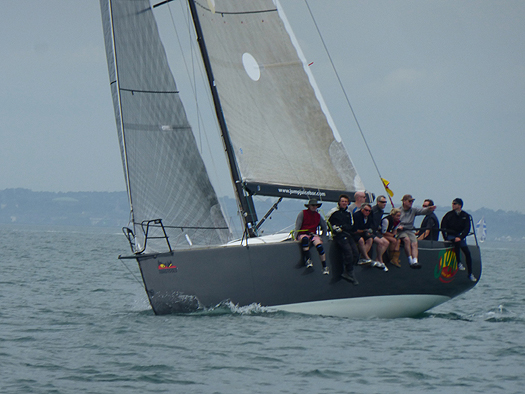
Winning tack. Jump Juice came down the bay in impressive style hard on the wind............Photo: W M Nixon
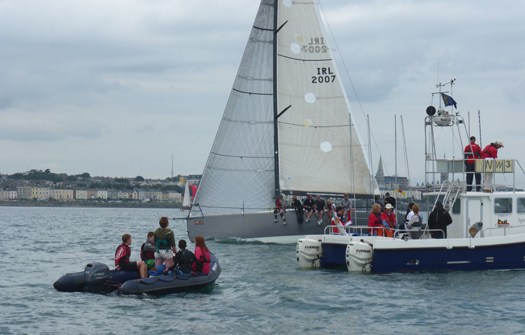
...........and her win move took her right through the Class 5 and 6 start area, but nobody batted an eyelid............Photo: W M Nixon
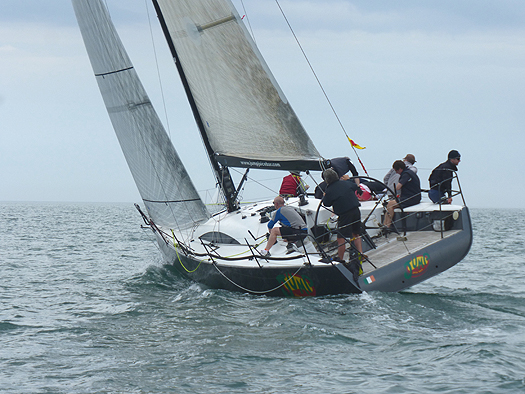
.....and it gave us an exciting glimpse of a top level racing machine. Photo: W M Nixon
That second race saw us sharing some sea space on the run with Classes 0 and 1, and as we were on starboard and interested only in maintaining our lead, some very expensive floating hardware had to throw some very neat gybes to allow the little Demelza to progress on her rightful way. But our afterguard being total boat addicts, they enjoyed nothing more than giving chapter and verse on each boat which came within range.
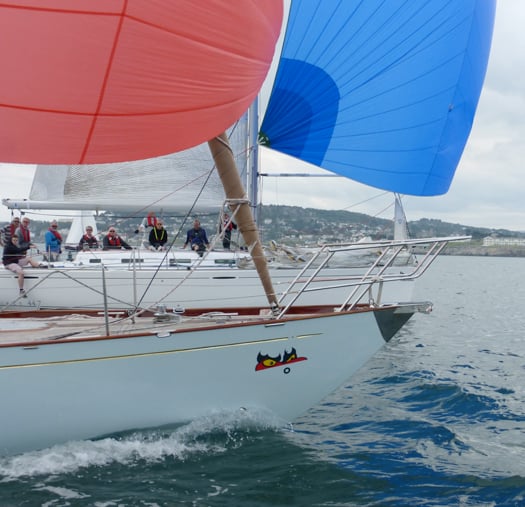
Mixing it with the heavy metal. The bows of the 54ft Soufriere and the 45ft Lively Lady after they'd neatly gybed their way out of a close encounter with the right-of-way Demelza. Photo: W M Nixon
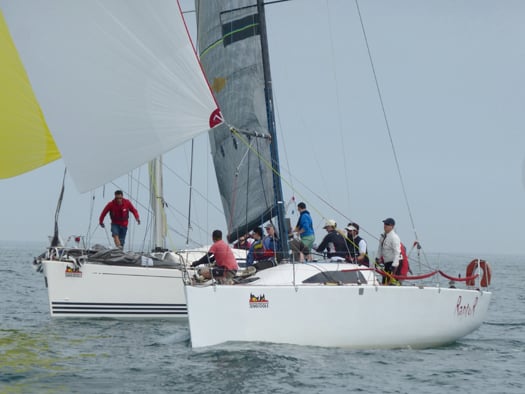
Raptor getting up to speed. She was one of the earliest Mark Mills designs, and was originally known as Aztec. Photo: W M Nixon
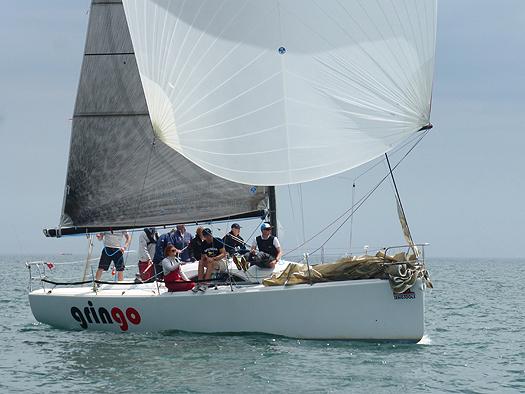
Tony Fox's Gringo, an A35, finds some sun on Dublin Bay. Photo: W M Nixon
The final beat saw Jim McCann with Peridot almost getting through, but sailing is a supposedly genteel sport which can show a discreetly killer side, so Windsor and Steffi were only delighted to throw a slam dunk right on top of their old friend, and go on to take line honours and their second corrected time win of the day.
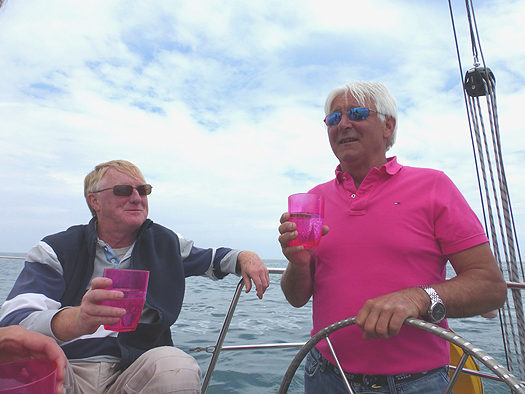
Second win, and line honours too – a bit of celebration for Conor Walls and the skipper. Photo: W M Nixon
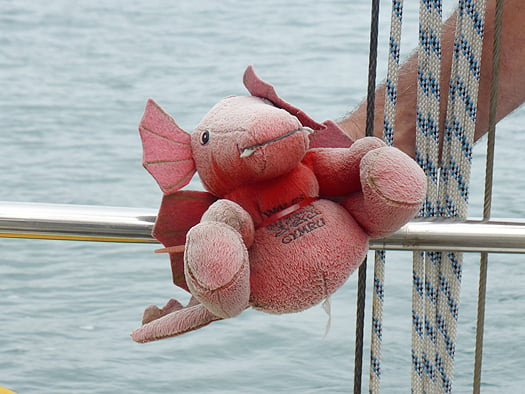
Demelza's current success is put down to the permanent presence on board of a lucky Welsh dragon. Photo: W M Nixon
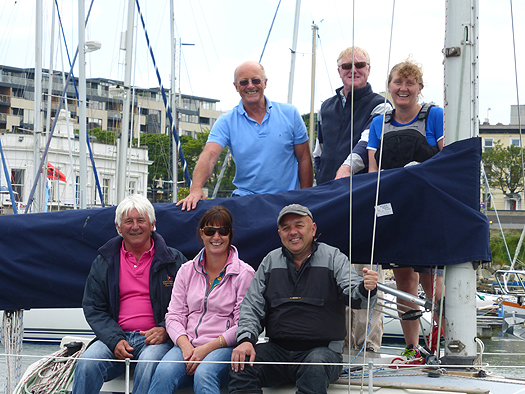
A crew of friends – racing Demelza to success are (front row, left to right) Windsor Laudan, Steffi Ennis and John Aungier, back row Francis Ennis, Conor Walls and Debbie Faherty Photo: W M Nixon
The morning's sunshine had given way to a silver-grey blandness in the weather, and to a casual observer, there might have seemed some blandness to the day's racing. But not for those taking part. I've long thought that trying to make sailing a spectator sport is a waste of time – either you take part, or you go off and watch something exciting like gardening. We'd had a marvellous day's sport, and it was followed by the usual high-octane banter at the club. The ICRA Nationals 2014 had got off to a good start. The race officers had their beloved results, with only one more race to sail to have a recognised championship. Let's hope the sun comes out today to sharpen up the sea breeze. Meanwhile, it was only after I got home I remembered it had been Friday 13th. And as for spinnakers? Well, believe me, there's life after spinnakers, there really is.
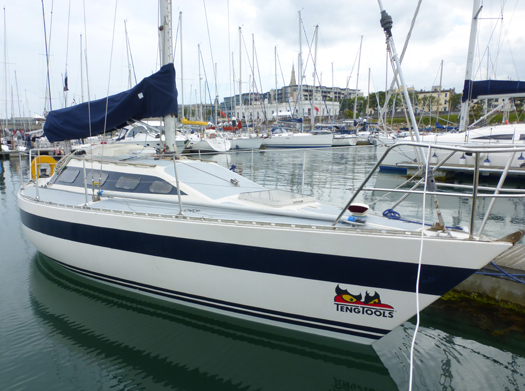
A well-loved little boat at rest after a good day's racing. In her successful 35 years, Demelza has been in only three ownerships. Photo: W M Nixon
#hyc – With only a week to go anticipation is building for the inaugural HYC Sportsboat Cup at Howth in County Dublin writes Ross McDonald.Three fleets will be battling it out over two racecourses in what is promising to be a spectacular addition to the Irish racing calendar. Racing will begin on Friday the 20th June and run over the weekend on what is the longest day of the year.
Racing will start at midday each day but the fleets will be back on dry land in time to take advantage of the late evening sun. Post sailing music and barbeques are booked for each day along with a sailing supper by HYC's new chef Jason Dunphy (ex Rolys, Conrad and more) on offer for Friday evening. On Saturday evening there will be a midsummer celebration with a dinner dance organised so the club will certainly be a lively spot.
The 1720 Europeans will be held as part of the event which is drawing an international flavour to the racing, with boats travelling from the UK to compete for the title. This is the first time in several years that this event has been held out of the 1720 stronghold of Cork and it is giving the boats from Dublin a new lease of life. Entries are coming in from the host club as well as The Irish, The George and the INSC in Dun Laoghaire. That's not to mention all of the old heads that are popping up on some of the regulars boats to rekindle their love of the 1720 and impart some local knowledge while at it. Boats are starting to arrive this weekend with the aim of familiarising themselves with race area.
The J24 fleet will be hotly contested with several seasoned campaigners and previous regional and national champions battling it out for the title. The fleet have lots of experience racing in Howth and are returning to the battleground of last summer's Worlds and the Europeans from 2011.
The J80s will be populated with lots of notable sailors across a wide range of ages. From young Oppie champions to world match racers and everything in between this racing is promising to be memorable. With all the boats rigged and tuned identically this fleet will come down to nothing but the sailors skills.
As well as awarding fleet prizes a perpetual trophy will be awarded to the overall event winner. The details of how it will be decided will be revealed in the SI's.
There is still time to get an entry in. You can enter online here
Howth Yacht Club Double-Handed Yacht Race Challenge to Feature Kish, Rockabill & Lambay
#hyc – Howth Yacht Club will run an open double-handed race on Saturday, August 23, 2014 for both spinnaker cruiser classes and white sail cruiser classes. The course will use the Kish Lighthouse, Rockabill lighthouse and Lambay and will start and finish at Howth's East pier. The course will be approximately 40 miles with a start time of 10am and hopeful finish time of late afternoon.
Double handed sailing is the fastest growing fleet within the RORC race calendar and so this challenge will give a taste of shorthanded sailing to HYC crews and hopefully will attract visitors from other local clubs.
Preparation and participation in the HYC Double handed Challenge is a great way for competitors to build shorthanded sailing skills and have a safe fun passage.
So put this in your diary, pick a crew (just one) and go for a practice sail. Entry forms, Notice of Race and Sailing Instructions will be posted soon.
Lambay Race Win for 'Bite the Bullet' off Howth
#lambay – Howth Yacht Club's 2014 Lambay Races were supported by a keen fleet of almost 120 boats, from the modern day stripped-out racers to equally spartan machines of 1898 writes Emmet Dalton. The Howth 17 Footer and Old Gaffer fleets avoided the nasty, modern business of a beat to a windward mark and started a half hour earlier from Howth's East Pier and made directly for Lambay. Selected results available to download below.
Meanwhile, their younger brethern, forever spending money trying to go faster, spent additional time sailing in the wrong direction from inshore and offshore start lines towards windward marks before deciding to turn towards the target.
Exotic materials are never a guarantee of success as the "Back" of Lambay snorted its usual laugh at the leaders. Skippers who bit off five metres too much or little towards the crags were rewarded with nothing more than gull droppings on their decks or inadequately muffled slagging from their faster moving neighbours.
The early part of the day didn't hold out much promise of the golden orb breaking through but as the race progressed and the rounding of a fog-cloaked Lambay was completed, there was enough sun to allow the salt to caulk on the faces of those closer to the front of boats.
This term's Top Boy was Colm Birmingham and his chums who took "Bite the Bullet" on a faster field trip than the other classes, bagging the (Anatomically perfect) Lambay Lady.
From our 17 Footer reporter, Mary Faherty:
Rita took the lead at the start. However Ian Malcolm's Aura overtook her just past Claremont Beach followed closely by Oona. Then the whole fleet disappeared into the heavy fog. Lambay was no where in sight and everyone was guessing compass bearings. When the sun finally broke through the fleet was just to the east of Lambay, again with Rita just in the lead. She held her position and rounded Lambay in first and finished a whooping 4 minutes ahead of the next boat. Oona and Aura raced for second place on the water. Hugh Walsh who had taken Sheila for the race and walked away with the handicap prize
Details from the Puppeteer 22 Class Captain, Cabbage Kavanagh:
In the Puppeteers the 14 boat fleet started with a short beat, rounded the windward and headed into the mist in search of the eastern end of Lambay. As always the racing was tight. After exchanging the lead several times, Eclipse slipped ahead of Blue Velvet behind the island and held on to take the BP/Teeling trophy on scratch, with Harlequin in 3rd and Odyssey squeezing in 4th, showing good speed on one of their first outings of the season. In the handicap division experience told with Cloud 9, rumoured to have competed in every Lambay race since 1906, taking the John Pearson cup, ahead of Schiggy in 2nd, Enigma in 3rd, doing well on their first attempt at Lambay, and Geppetto in 4th.
#hyc – This weekend, Saturday June 7th, Howth Yacht Club once again hosts one of Ireland's longest established events, the Lambay Races. The event has been part of Howth's sailing calender for well over 110 years, the first trophy dates back to 1899 and was put up by a member of what was then Howth Sailing Club.
Saturday's event is proudly sponsored again this year,by Trustee Decisions Ltd. - a specialist company providing professional advice to trustees of private and public group pension schemes.
Apart from the usual inshore and offshore fleets, HYC will also have a throwback to the traditional Lambay races with the Howth Seventeens starting off the east pier and finishing in Howth Sound. The return to the tradtional Lambay course was discussed recently in WM Nixon's Sailing blog.
There will also be a pier start for classic boats which will hopefully include a Galway Hooker.
This change in format for traditional classes is the idea of Bryan Lynch and is to mark the centenary of Echo (no. 8) which has been in the Lynch family since 1969 and is currently owned and skippered by Bryan's daughter Harriet.
As the entries roll in, it seems that the Puppeteers will end up being one of the biggest fleets. Every inch of the 16 or so mile race track will likely be needed by whomever will end up claiming the Lambay Lady trophy, which is awarded to the boat that wins its class by the largest time differential over the boat that comes second.
Leaving aside the excellent racing that the event usually provides, the onshore festivities start early on Saturday morning with coffee and bacon rolls, bar food and barbecue available all day, the prize giving will take place at 17:30 and dinner is available in the dining room from 18:00 (booking essential).
Music and dancing will be provided by Buck Taylor, a James Taylor tribute act with DJ David O'Shea continuing the fun until late.
Entry is available on line here
#etchells – Ireland has a single entry in a 95–boat fleet for the 2014 Etchells keelboat World Championship from June 21 to 28 in New York. The class's 46th world championship will be one of the biggest and most competitive in its celebrated history.
Malahide and Howth Yacht Club sailing family trio, Richard, David (a four time Olympian) and Samantha Burrows are entered in the Corinthian, Masters and Seniors divisions in a fleet that has already attracted some of the world's top professional and amateur sailors.
Long Island Sound yacht designer and builder Skip Etchells created the 31-foot keelboat in 1965 hoping to win selection as the new Olympic keelboat.
The design dominated the racing in the selection trials, but lost in the onshore voting for Olympic status. For the 2016 Olympics, there will be no keelboat sailed in the Olympic regatta.
But nearly 50 years after the first Etchells touched the water, the class is as strong as ever.
The number of entries in recent class world championships has varied from 41 last year to a high of 100 in 1998.
Up to nine races are scheduled, all but one of which will count toward a team's final score. Registration and measurement for the regatta will start on Saturday, June 21, with the racing taking place on Rhode Island Sound, Tuesday, June 24, through Saturday, June 28.
For an entry list click here.
#hyc – Simplify the courses, make the starts more accessible, and sign up interesting boats, ideally with historical interest - those are some of W M Nixon's suggestions for stimulating sailing.
They're going back to their sailing roots in Howth. The historic Lambay Race in a fortnight's time will re-introduce the traditional direct course round the island for both the venerable Howth Seventeens, and a special class for Classics and Old Gaffers.
The annual race round Lambay has been a part of the local sailing calendar for at least 110 years. With the first known Howth regatta being staged in 1857, doubtless the island was used as a very clearcut race mark several times during the 19th Century. But it wasn't until 1899 that a Lambay trophy was finally put up by a member of the relatively new Howth Sailing Club (founded 1895), and it is 1904 before we find any reference to such a race being held.
Howth SC was a tiny club, and the earliest records of its sailing results are very sketchy. To keep the tally, they often ended up relying on inscribed trophies and the occasional newspaper reports. But trophies went missing, and with the big clubs on Dublin Bay and Cork Harbour getting any media attention going, Howth scarcely registered on the newspaper radar at all. Then with six members – or more than 10% of the active membership – killed during the Great War of 1914-18, there were other things to think of, and it isn't until the 1920s that we have anything like a clear idea of what was going on with the Lambay Race.
The way it was reported suggests that it had been a well-recognised event since the early 1900s, and the course was firmly established. Start off the pierhead (time to be taken from Findlater's clock), through the Sound leaving Ireland's Eye to starboard, then round Lambay leaving it to port, and back to the finish through the Sound, this time with Ireland's Eye to port. It's only about 16 miles in all, but it can be a course with a bit of everything.
And it was so beautifully simple - even the business of hitting the main mark of the course didn't merit disqualification as you were aground, and had more than enough problems to be going along with, without being chucked out of the race as well.
It was a format which worked well until the 1970s, when fancy notions of always having windward starts from a committee boat, with all sorts of other course permutations round laid marks, were added to the ancient mix. This new approach worked well enough for a while, as sailing numbers were increasing in any case. But the new devotion to serious racing began to stray from the old Lambay ideal of celebrating a coastline by racing round its main island.
Thus at a time when the straightforward Round Gotland Race in Sweden was building its steady rise to becoming the Baltic's most populous sailing event, and the equally straightforward Round the Island race round the Isle of Wight in the south of England was doing the same in the Solent, the much longer established Lambay Race in Ireland was straying further and further from the attractive simplicity of its original concept. Gung-ho Race Officers, obsessed with the ideal of the Olympic-style course, began setting ever-more artificial courses in which Lambay was so much reduced to being merely another mark of the course that, on one eminently forgettable occasion, the fleet didn't actually round the island at all.
My own disenchantment with the new regime came on a day of light westerly winds, when a Race Officer obsessed with fitting in a long windward leg set a Lambay Race course which also took in the Kish Lighthouse eight miles offshore. As it happened, our crew included two guys who had to be in Athlone that night by 9.30pm in order to play a weekly gig with a showband. In those pre-motorway days, just getting to Athlone was a night's work in itself. So when the breeze faded, we'd to pull out so they could get to work on time.
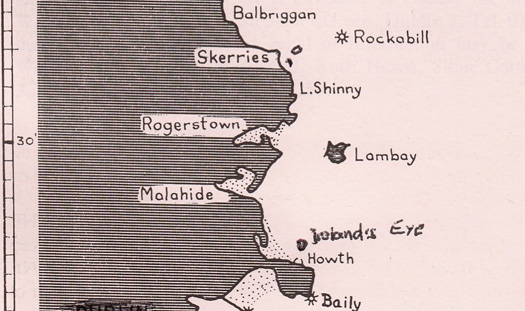
What could be simpler? A basic course using Lambay as the turning mark removes cockpit confusion
As it happens, the breeze filled in just enough for those still racing to complete the course minutes ahead of the absurdly late time limit of 8.0pm. With the calm in the middle, and then the better wind filling in later, the handicap placings were simply the reverse order of boat size. The smallest boat won, and as we were the second smallest boat racing, had we been able to stick at it we might have been at least second. Yet the disgruntlement wasn't directed at the demands of showband gigging in Athlone. On the contrary, the annoyance was with race officers who think that even the most traditionally fun-filled racing celebration of a beloved island and its nearby area of Irish coast should be made such a deadly serious business.
Just now and again, we need to lighten up in our sailing. By all means be vigilant in safety and in respecting the rules of the road in seafaring. But for heaven's sake just once in a while, let's race a simple course along attractive bits of coastline as much for the fun of being among other boats and sailing the sea, and the beauty of the coastline, as for the competitive sport involved.
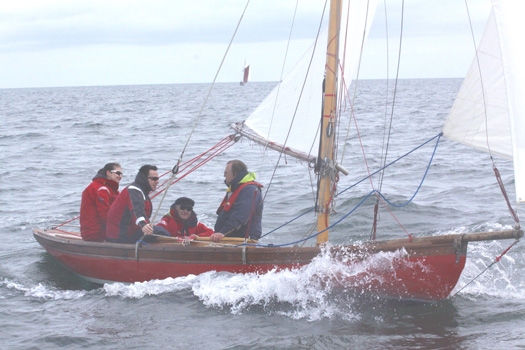
The folk who have made it happen. Harriett Lynch on Echo's helm (left), with her father Bryan second from right. Our photo shows them last year as they were about to demonstrate to the Old Gaffers how to do it, by sailing their engine-less little boat round the Kish despite forecast of calms. This year, to celebrate Echo's Centenary, they and the rest of the Howth 17s will sail a traditional course round Lambay. Photo: Dave Owens
For this year's Lambay Race on Saturday June 7th, there's a glimmer of fresh hope. Bryan Lynch is a stalwart of the Howth 17 class. He has been involved with these attractive little boats since at least 1965, when he and his brother Mark bought Pauline, No 2. Then they were out of ownership for a little while, but soon back in together again with Echo (No 8) in 1969, and then in 1974 Bryan became Echo's sole owner as Mark had bought Eileen (No 16).
They were adventurous times for the Seventeens, as the Lynch brothers, in addition to the regular summer programme at Howth which provides the class with 60 races every year, also cruised with two of the boats to Ardglass and the Isle of Man. So although Mark has now moved on to a "plastic gaffer", the 22ft Cornish Crabber Alice, Bryan continues in the Howth 17s although these days the owner-skipper of Echo is his daughter Harriet.
Last year when the Old Gaffers were celebrating their Golden Jubilee in Dublin Bay, the Seventeens showed their mettle with the main fleet racing round The Baily to the celebrations at Poolbeg and in the Liffey, but the Lynches with Echo, together with Ian Malcolm in another Seventeen, Aura of 1898 vintage, elected to have a match race round the Kish even though the inaugural DBOGA race for the Leinster Plate, which might have raced to the Kish, was shortened to the North Burford as lighter winds were forecast.
But the two little Seventeens found enough breeze to get there and back. Ian Malcolm had brought along an outboard just in case, but Echo and her gallant crew were entirely wind-reliant, and it was the successful beginning of a buildup to this year's big celebration, which is Echo's Centenary.
She was built in Dublin by Hollwey of Ringsend in 1914, and to mark the special year, Bryan Lynch requested that for the 2014 Lambay Race, the Seventeens be sent on the traditional course which Echo will have sailed in her maiden season in 1914.
He found he was pushing on an open door. Not only have the grand fromages in Howth Yacht Club willingly agreed, but now they've leapt at the idea of having a start for classics and traditional boats over the old Lambay course as well, also starting off Howth's East Pier. The start gun for the Seventeens will be at 1130am on Saturday June 7th, and the Classic & Gaffers at 1135am, or maybe with all those bowsprits milling about, they might allow a full ten minute gap. Whatever. But who knows, there might even be enough interest for other cruisers who want more of the simple old course, to be given a gun five or ten minutes after that again.
This all means there's been a revival of interest in the Lambay Race of 1921. Thanks to an article in the annual Journal of the Humber Yawl Club for 1922, that's the earliest detailed record we have of the cruisers' section in any Lambay Race. The winner was John B Kearney's 36ft gaff yawl Ainmara, which he'd designed and built himself, while second was Pat Walsh's sweet little 25ft gaff yawl Sheila, an Albert Strange design built in Peel in the Isle of Man in 1905.
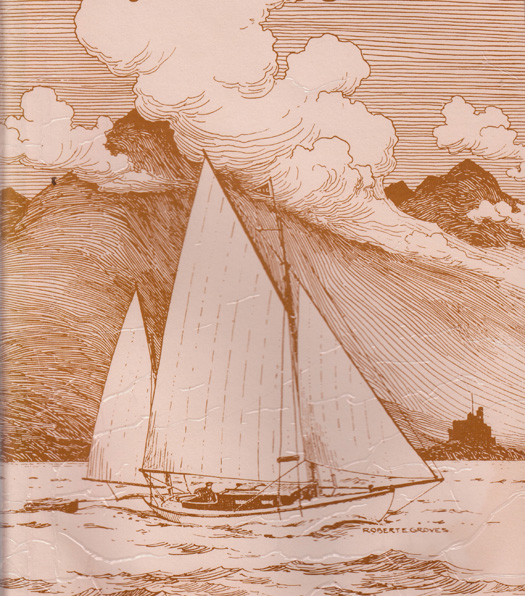
The 25ft Albert Strange-designed gaff yawl Sheila on the West Coast of Scotland in 1909 as sketched by her first owner, marine artist Robert E Groves. Sheila placed second in the Cruiser Class in the Lambay Race of 1921.
Remarkably, both boats still survive, but it is only Sheila which is still in original form. These days she's based on the River Deben in Suffolk on England's East Coast, and as it happens she has just been advertised for sale in prime condition through woodenships.co.uk at £22,000. So if you get your skates on (having won the Lotto), you just have the time to get her to Howth to race again against Ainmara on June 7th.
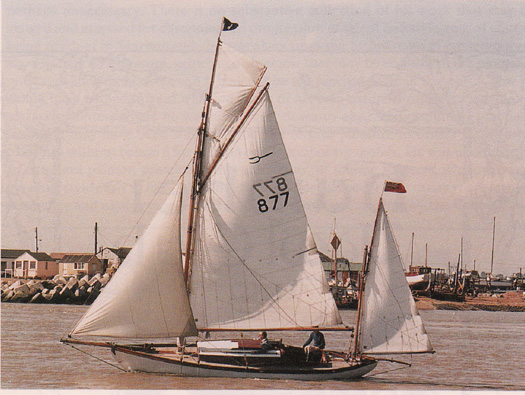
Sheila as she is today in Suffolk, in classic order and for sale at £22,000
Ainmara's hull today is unchanged, but though she was originally noted as a good heavy weather boat with a compact gaff yawl rig and a mainmast only 37ft 6ins long, in the 1930s she was given a massively heavy Bermudan mast. So when owner Dickie Gomes of Strangford Lough was fitting her with an alloy spar which he built himself with the help of specialist friends in the late 1960s, he moved the mast 18ins aft, as John Kearney had originally suggested when he heard – with misgivings – that the change to Bermudan was being made.
Ainmara was in Dublin Bay last year for the inaugural Leinster Plate, so she hopes to be back this year to defend it on May 31st, and then all being well she'll stay on for a week to race again round Lambay on the traditional course on June 7th. To get an idea of how she looked in 1921, this photo of her in 1967 under her first forward-located Bermudan mast is helpful if you can imagine the top third of the Bermudan mainsail removed, and visualise a gaff sail instead, set on a keel-stepped mast whose overall length was only 18 inches longer than the boat's hull LOA of 36ft.
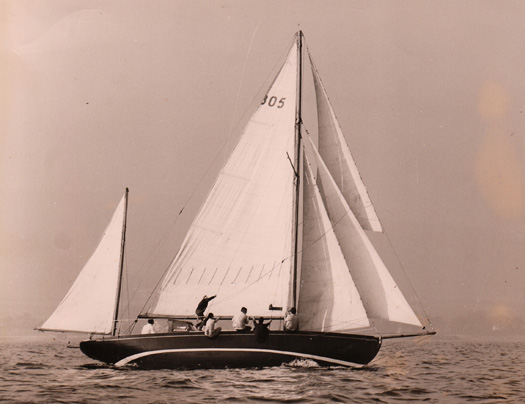
Ainmara in 1967, with the Bermudan mainmast still in the forward position. Try imagining her as gaff rigged, with the mainmast only a little bit longer than the hull. Photo: Denis Pogson
The photo also shows just how very right John B Kearney got his hull lines first time out. Ainmara is one very sweet shape. As Kearney had a fulltime and very demanding job in the engineers department in Dublin Port, his relatively few designs are of special interest, and there's always been particular interest in a design attributed to him from 1924, the 27ft straight-stem yawl Dolphin.
As even a brief study of Kearney designs reveal, he created a distinctive and yacht-like style. The 34ft yawl Sonia, which he designed for, and built with, Bill Blood Smyth in 1929 is essence of Kearney, as we can see from this photo when she was in the ownership of Pierce and Denis Purcell of Dun Laoghaire in the 1940s and '50s.
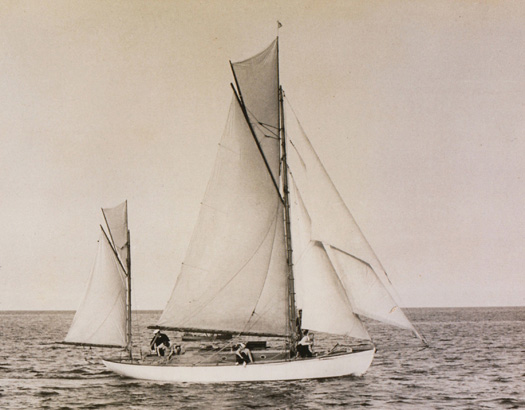
The 34ft 1929 Kearney yawl Sonia (now based in Vancouver) in the ownership of Pierce & Denis Purcell of Dun Laoghaire in the 1940s and '50s, bearing off to oblige the photographer, and showing a remarkably labour-intensive rig with a jib topsail, a topsail on the mizzen, and a topsail on the main. There'd be a mizzen staysail as well, in addition to a spinnaker....... Photo courtesy Pierce Purcell Jnr.
Yet the few written records and folk memories confidently assert that Dolphin is a Kearney design. I can remember her so well from many years around Strangford and Belfast Lough in the ownership of the great Davy Steadman, who once cruised her right round the southern half of Ireland, and then returned as planned through the Shannon and the Grand Canal, no problem as she was shoal daft and had her mainmast in a tabernacle.
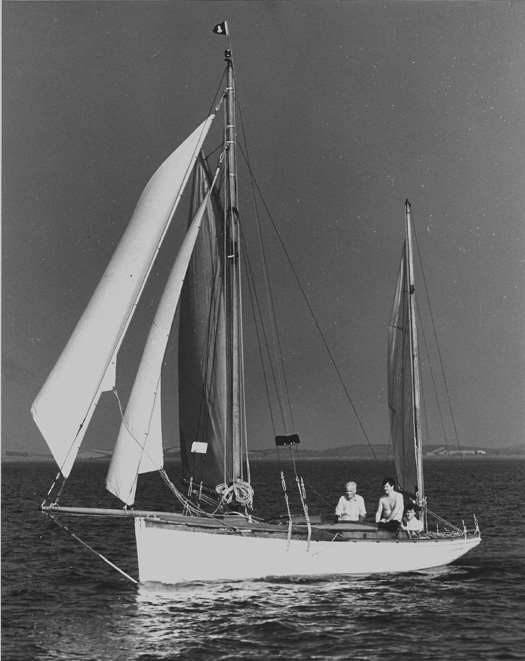
Dolphin on Strangford Lough during Davy Steadman's long and happy ownership. Photo: Ann Clementson
The answer to Dolphin's origins came in a real lightbulb moment at the final winter meeting of the DBOGA in Poolbeg Y&BC in March. You never know what's going to come up at these Gaffer gatherings. For instance, I now know in considerable and entertaining detail just why the Castletownbere lifeboat is called the RNLB Annette Hutton, thanks to DBOGA President Tim Magennis having to give us a brilliant impromptu talk when a scheduled speaker failed to show.
At the concluding meeting this Spring, the magic moment came at the end when Cormac Louth suddenly stood up and made an impassioned plea for any memorabilia of any kind at all relating to the fact that between 1818 and the outbreak of the Great War in 1914, there were very strong links between the old fishing community of Ringsend and the great fishing port of Brixham on the south coast of Devon. They were links so strong that today there are many people in Ringsend with Devon surnames, yet there is now virtually no contact between Dublin's most ancient maritime community and the "home port" in southwest England.
It's the sort of nugget of information you squirrel away to examine in detail later. But the lightbulb moment was the sudden realisation that, thanks to the Brixham link, Dolphin might indeed be a John B Kearney design. It's perfectly possible that in 1924 someone asked him to create the plans for a little clinker built cruising yacht whose lines would faithfully reflect the shape of the classic Brixham trawlers, which they'd known in Ringsend for nearly a hundred years.
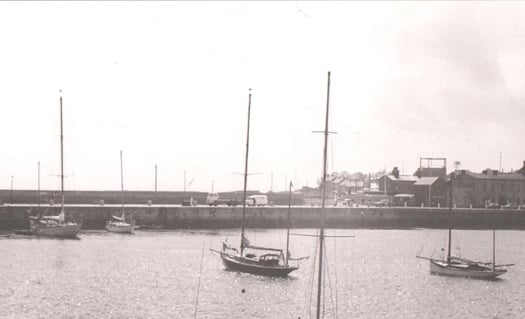
A unique mix of Kearney designs in Donaghadee in 1966. On the left is Perry Greer's 1963-built 54ft Helen of Howth, John Kearney's last and largest design. At mid-harbour is the 36ft Ainmara (1912), his first yacht. And on the right is the 27ft Dolphin (1924), which seems to have been inspired by the classic form of the Brixham trawler. Photo: W M Nixon
Once the Napoleonic Wars ended in 1815, the men of Brixham could start expanding their fishing ambitions, and their increasingly superior boats out-performed most other ports, with the Brixham influence spreading as far east as Ramsgate in Kent, and as far west as Ringsend in Dublin.
With the technological developments accelerated by the World War I, sailing fishing boats were being rapidly replaced by steam and then diesel, but by this time the Brixham vessels had reached an exceptional standard. As big class yachting slowly revived after the war, the regatta circuit made its annual visit to Torquay just across the bay from Brixham. When the skippers of the giant cutters said they couldn't race in the strong winds prevailing as their rigs would become dangerous, the Brixham trawlers contemptuously went forth in full array to show their class, and the Brixham Trawler Regatta came into being.
But with the disruption of the Great War followed by the War of Independence, Ireland's links to Brixham had faded, yet for many in Ringsend, the Brixham trawler remained the ideal, for they were handsome yet able boats. And this gave me another magic moment on a recent Saturday evening in Bridie Keating's pub at Derrynane in far southwest Kerry.
There on the wall, amidst photos of local sailors including Damian Foxall, is an ancient colour photo of the Brixham Trawler Provident. For many years, she was owned by the co-operative known as the Island Cruising Club of Salcombe in Devon, and for most of its members, an annual cruise fetching up in the sublime anchorage of Derrynane, with a spot of conviviality ashore in Bridie's, was what life was all about.
Provident was built in 1924, and so too was Dolphin, and their hull resemblance is startling. Yet it's doubtful if the two boats have ever been together, and it's now unlikely if they ever will be. The last I saw of Dolphin was two years ago in a corner of a little old boatyard near Monkstown on Cork Harbour. Back in 2012, she could maybe have been saved, though only with enormous expense and effort. But it's unlikely that could be done now, yet if she still exists at all, it might be worthwhile to take off her lines.
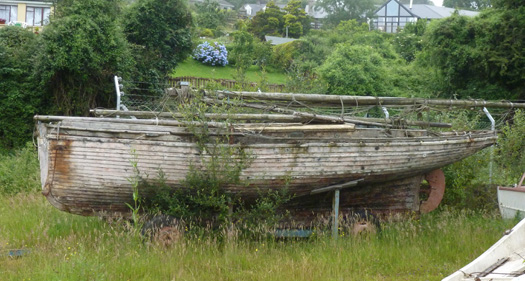
A sad sight. Dolphin in 2012. Photo: W M Nixon
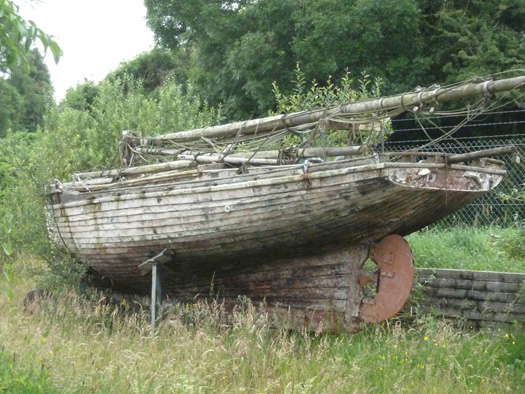
Although clinker construction poses special preservation problems, much of Dolphin's timber seemed in surprisingly good order despite years of exposure and neglect. Photo: W M Nixon
However, the news on the 70ft Provident is good. She's in fine shape after a recent major refit for owners Trinity Sailing Trust, and is based back home in Brixham, the very essence of what a first class Brixham sailing trawler was and is all about.
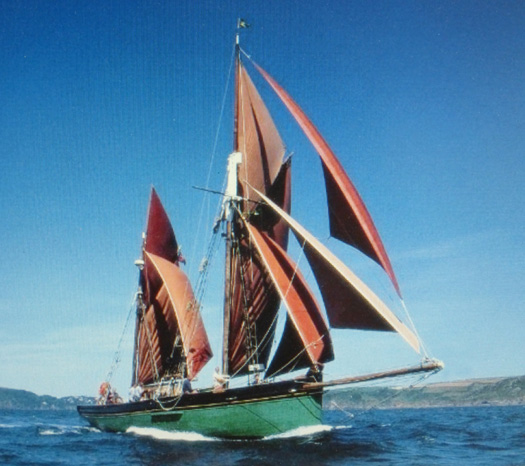
Provident in all her glory. Owners Trinity Sailing Trust have recently given this historic Brixham-based vessel a complete refit.
Rory Fitzpatrick Wins Howth YC Round of Irish Moth Tour
#moth – Six wins for Rory Fitzpatrick of the National Yacht Club gave him the overall lead in the second round of the Irish Moth tour at Howth Yacht Club at the weekend. The Dubliner discarded a second in the penultimate round of the foiling class to be a clear winner ahead of club mate John Chambers who had three seconds and four thirds in the seven race series (video above). Third was Wexford's Ronan Wallace and fourth the National's Annalise Murphy. Results available to download below.
Two Irish Teams Contest British Team Racing Trophy
#wilsontrophy – Two Irish teams will contest The Wilson Trophy British Open Team Racing Championships are to be held on West Kirby's Marine Lake this weekend (9th – 11th May) and will be hosted by West Kirby Sailing Club (WKSC). Dublin teams from Howth Yacht Club and the Royal St. George YC are travelling to Liverpool for the event now in its 65th year. This unique and spectacular team race sailing event will be welcoming 32 of the finest teams from around the UK, USA and Ireland including three teams from WKSC itself.
Aswell as the Irish participating teams, there will be two Irish umpires at the event. Irish national umpire Cxema Pico is attending and International Judge and national umpire Gordon Davies in also on duty.
The 192 competitors will be sailing in 12-foot dinghies known as Fireflies while under the close observation of some of the best umpires from the UK and overseas. Competition will be fierce this year as some of the traditional teams have disbanded, with sailors joining other teams to try and find that winning formula.
Racing starts at 1pm on Friday 9th May and continues through to late Sunday afternoon. Weather permitting, there will be over 350 fast and cut throat races to watch. The Marine Lake, otherwise known as the 'theatre of dreams', provides a natural amphitheatre where members of the public are encouraged to come and watch the action from the Grandstand on West Kirby promenade (by the old baths). The Visitors Centre and live commentary will also help to explain some of the nuances of the racing to spectators and passers-by.
David Taylor, Commodore of West Kirby Sailing Club, said: "We are thrilled to be hosting this fantastic event, now in its 65th year. It's great to see so many people travelling from near and far to sail on the Marine Lake and enjoy its beautiful surroundings.
"The club is extremely proud to host this event each year and we always aim to provide both the competitors and our local community with a weekend of sporting action that they won't forget."
The three-day event will be an exciting and fun weekend for spectators and competitors alike with a thrilling demonstration of top level sailing, which is free to watch. The final rounds are scheduled to take place on Sunday from 1pm, when the action reaches its climax, with the top eight of 32 teams entering play-offs to take home the celebrated trophy.
The 2014 Wilson Trophy is delighted by the support it has received from many individuals and businesses, including leading sponsors: Carlsberg, Everite Windows, GJW Direct, MI Finance and Speed Medical.
Follow the results at: www.wilsontrophy.co.uk
#isora – The arrival of three Howth Yacht Club boats onto the ISORA scene this season has produced immediate results with HYC entry Dux, an X302 yacht skippered by Anthony Gore-Grimes winning the first ISORA race from Dún Laoghaire to Arklow on Saturday.
Although the strong winds and big seas cancelled most of the local inshore racing for Dublin Bay Sailing Club (DBSC), the 15–offshore yachts came to the line off Dun Laoghaire's East pier in what was some of the strongest breezes of the day. Dux followed by top performing J109 Ruth (Liam Shanahan of the National Yacht Club) made the best of the 40 – knot southerly winds that saw a number of retirals on the upwind leg along the Dublin and Wicklow coasts. Conditions dictated a shortened course to the Wicklow outfall buoy instead of North Arklow, a reduced distance of some 38 miles instead of 50 that produced an early (and welcome) high speed reaching leg back to Dublin Bay.
The provisional results for Race 1a - the Dún Laoghaire day race (incorporating the first Royal Alfred Yacht Club Coastal Series) is available to download below as a jpeg file.
In a move that has drawn the international support of ISAF's offshore working party, the ISORA crews are experimenting with iphone navigation during the race and 'virtual marks' to adjust the courses.
In deploying the new mobile technology ISORA has teamed up with app developer 'Predict Wind Tracker'.
Unfortunately on Saturday, ISORA did not get to use them to full effect. The weather was so awful that the basis of the course was to keep as close to land as possible but away from banks and headlands.
This, says Peter Ryan of ISORA, is a cost effective method of recording any offshore race that can be viewed live and also replayed after the event. ISAF's David Brunskill has offered to judge any issues surrounding the use of the virtual marks.
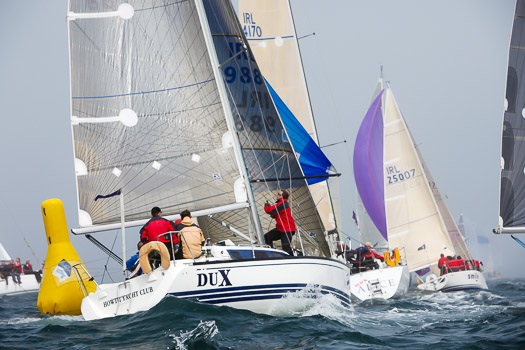
First race winner Dux sailed by seasoned campaigner Anthony Gore-Grimes' Photo: Robert Bateman
Ryan adds that if the innovative approach to setting courses is successful, 'it will radically change offshore racing to the betterment of all', a sentiment supported by the world sailing body.
The next race is the Holyhead to Dún Laoghaire qualifying race on 10th May. This is followed by the return race from Dún Laoghaire to Holyhead on 24th May. One of the highlights of the ISORA series this year is the Midnight Race from Liverpool to Douglas on 6th June.



























